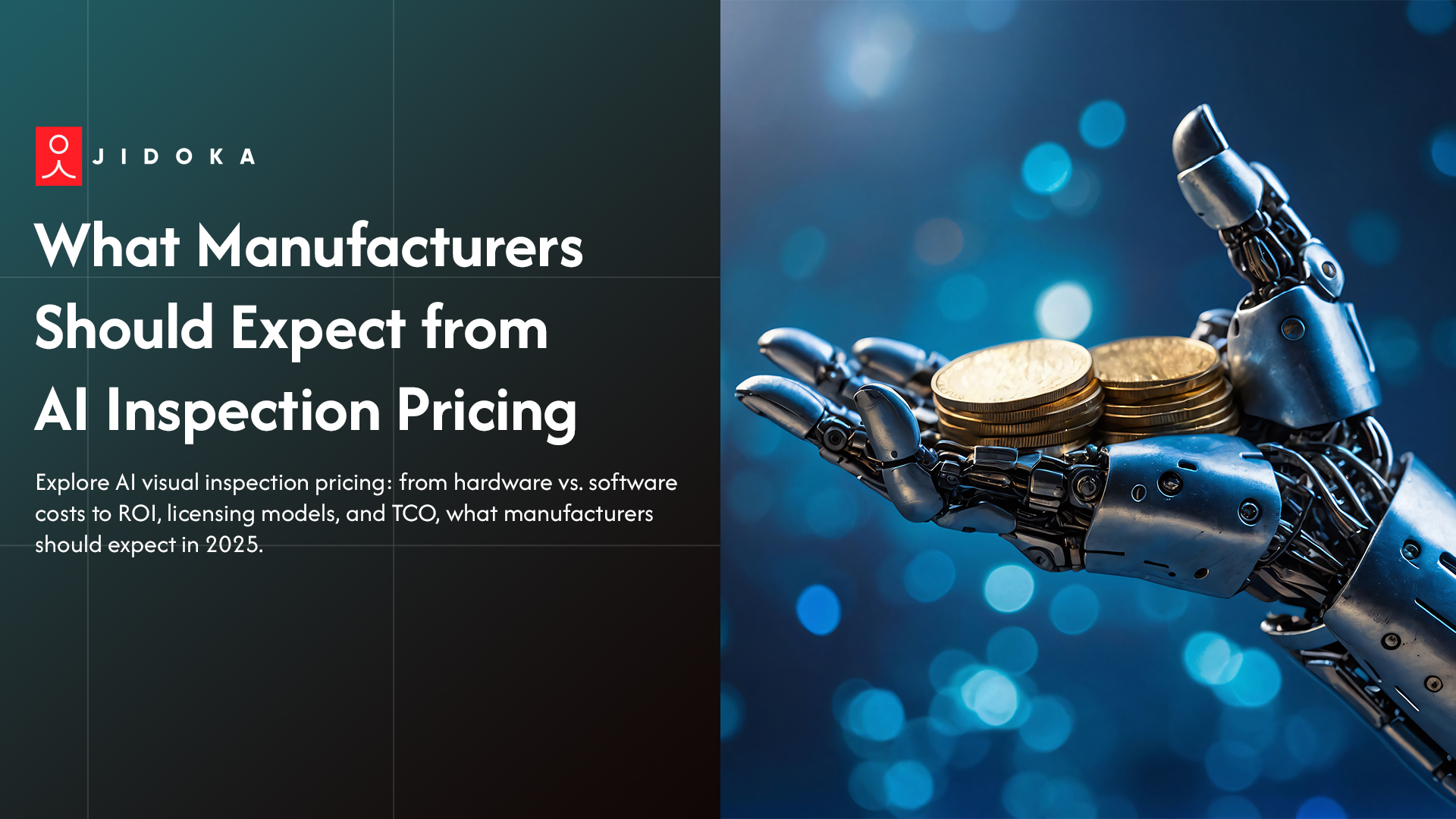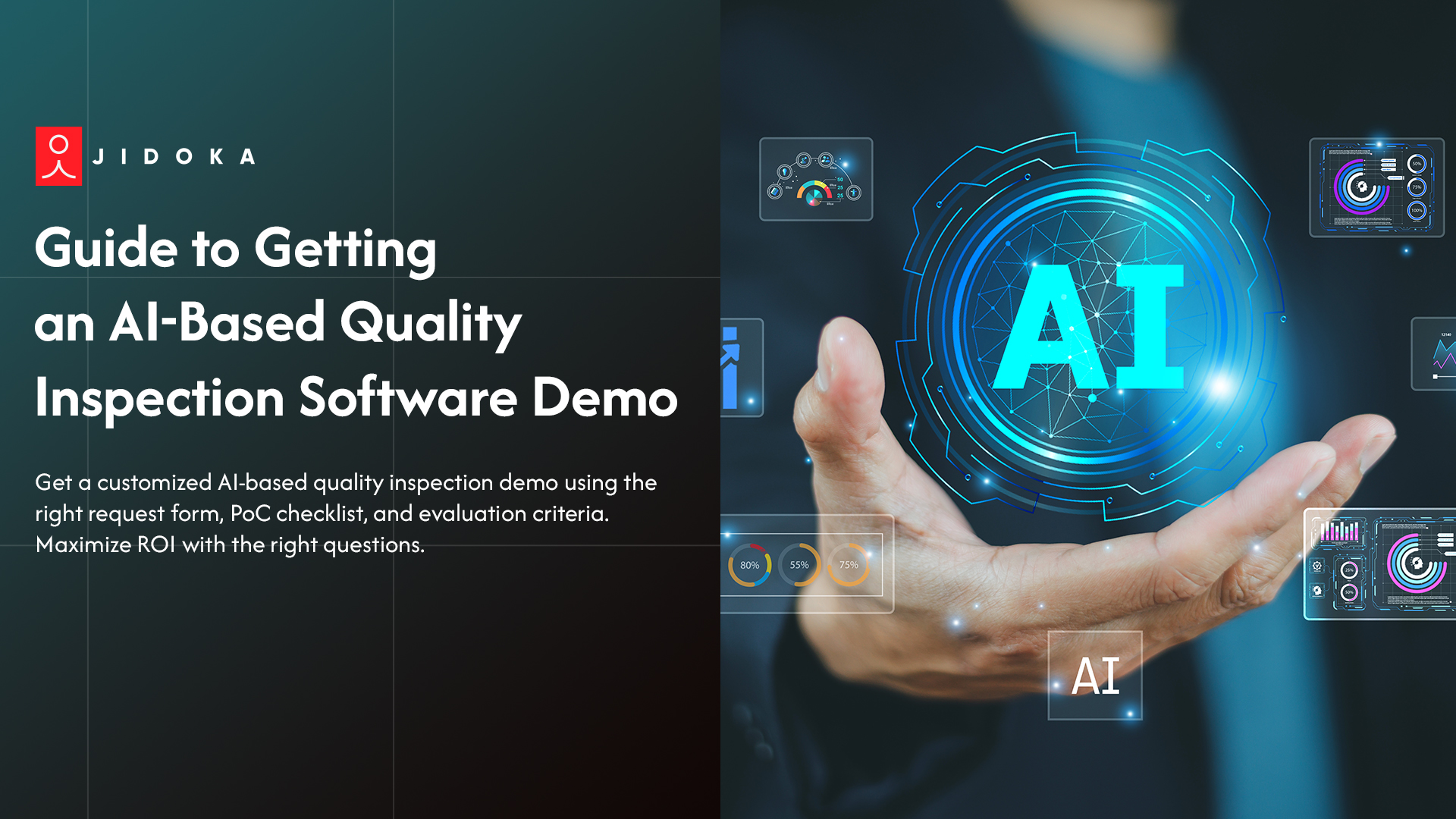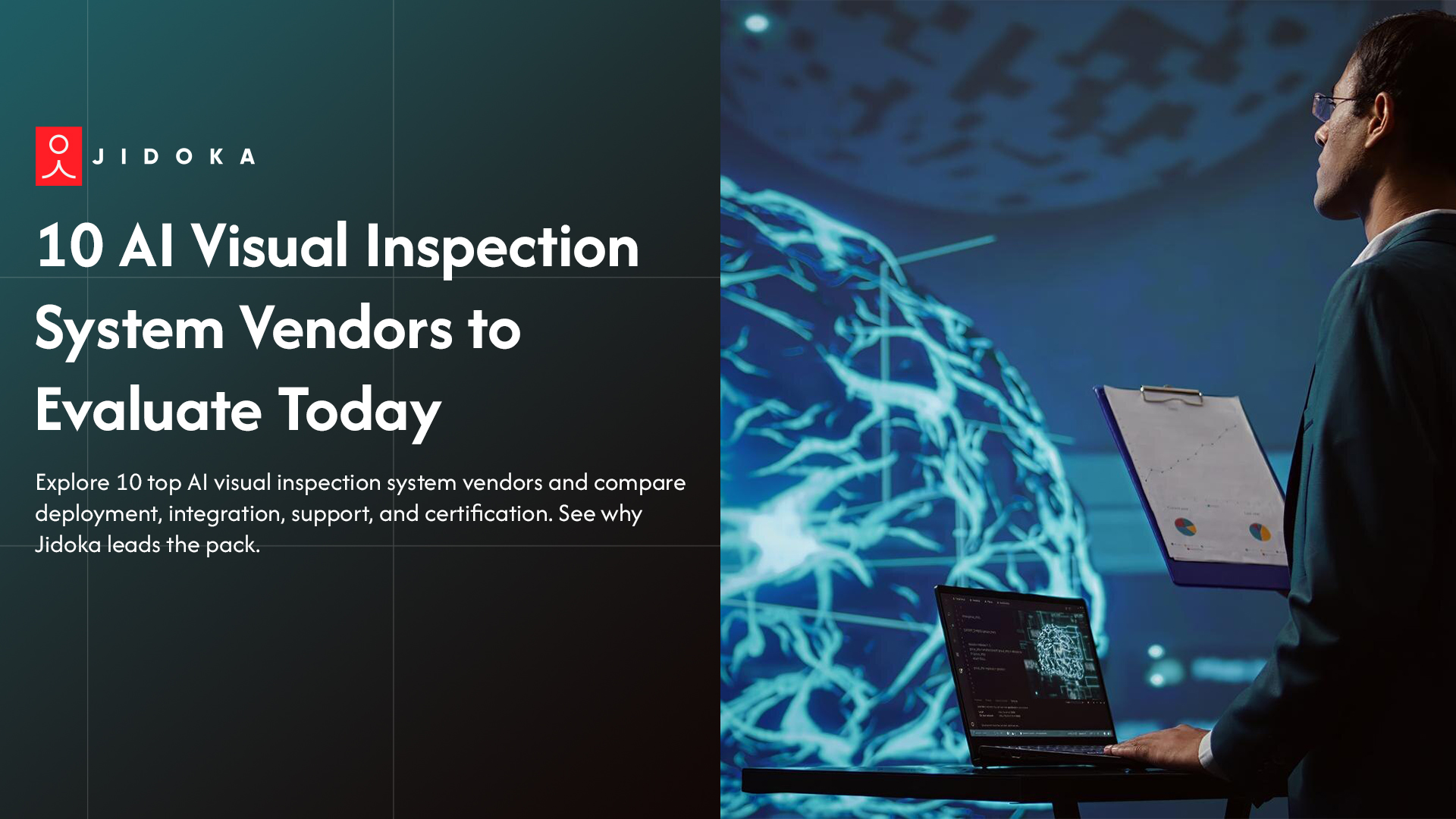Quality failures cost U.S. manufacturers trillions every year. One missed defect can trigger recalls, lost clients, and production downtime. That’s why more factories now rely on vision inspection as a core part of industrial quality control.
Instead of just spotting errors, modern systems with deep learning quality control detect complex defects, learn from variations, and keep improving over time. The machine vision systems market is expected to grow fast in 2025, signaling a clear shift toward smarter, self-learning inspection.
That’s where Jidoka comes in. It connects intelligent inspection with responsive automation to detect issues early and stop repeat failures before they become costly.
Why Traditional Vision Inspection Fails in 2025
Modern factories rely on vision inspection to maintain speed and accuracy, yet many still use systems built on outdated logic. These setups rely on fixed thresholds and pixel counting, which break down when lighting, texture, or color changes. A small glare or surface reflection can flag a perfect product as defective.
This makes production unpredictable, lowers yield, and weakens industrial quality control. As automation expands, teams now need smarter vision inspection systems that learn instead of following instructions.
1. The Flaw of Traditional "Rule-Based" Vision
Traditional tools depend on rigid rules that don’t adapt. Every variation in product texture or background light forces engineers to retune parameters manually.
Common issues include:
- Flagging normal variations as defects during automated visual inspection
- Generating repeated false positives that waste good products
- Increasing downtime from frequent recalibration
- Missing subtle defect detection that affects performance
These systems create noise instead of insight. Over time, factories lose both accuracy and efficiency.
2. The AI & Deep Learning Difference: From "Rules" to "Judgment"
AI-driven vision inspection replaces rigid instructions with intelligent pattern recognition. Through deep learning quality control, systems study examples of good and bad products to make independent, adaptive decisions.
Key improvements include:
- Understanding natural texture changes and reducing false positives
- Identifying complex defects across materials and finishes
- Boosting machine vision systems accuracy by learning from real-world data
- Adapting instantly without manual retuning
This evolution makes vision inspection a core driver of industrial quality control, turning inspection from a reactive task into a predictive one.
Next, we’ll explore the three major technologies shaping this transformation in 2025.
The 3 Pillars of Modern Industrial Quality Control in 2025
Modern vision inspection is no longer limited to spotting defects. It focuses on building reliability into every production step. Today’s factories use AI, 3D imaging, and edge computing to make industrial quality control faster and more accurate.
These technologies power next-generation systems that learn from data, adapt to variation, and make real-time decisions on the line.
Pillar 1: AI & Deep Learning Quality Control
Application: Deep learning quality control is applied to production lines where materials and textures vary widely. It trains on examples of both good and defective parts to recognize patterns that traditional rule-based systems miss. From metals and plastics to fabrics and food, it delivers consistent and reliable inspection results.
Benefits include:
- Detects complex or unpredictable defects with high accuracy
- Reduces false positives that lead to wasted material
- Improves stability across shifts and production runs
- Enhances automated visual inspection with self-learning models
AI turns vision inspection into a smarter decision-maker, not just a defect detector. Next comes 3D vision inspection, which adds dimensional awareness and helps ensure products meet every physical specification.
Pillar 2: 3D Vision Inspection for Volumetric Accuracy
Application: 3D vision inspection adds dimensional precision to industrial quality control by using sensors that capture height, depth, and shape. It measures contours, seals, and assemblies in real time, helping identify dents, gaps, or misalignments invisible to traditional 2D cameras.
This ensures consistent vision inspection performance across complex geometries.
Common uses include:
- Measuring dent depth, seal flatness, and cap height
- Verifying adhesive bead volume for uniformity
- Detecting warps or misaligned components
- Improving defect detection in assembly and packaging
By adding depth perception, 3D vision inspection turns surface-level inspection into complete product validation. Next, we move to Edge AI, where intelligence shifts directly to the camera for instant and more efficient automated visual inspection.
Pillar 3: Edge AI for Smarter, Faster Decisions
Application: Edge AI transforms vision inspection by processing data directly on the device instead of sending it to a central computer. This localized intelligence allows machine vision systems to analyze images, detect defects, and make instant decisions right on the factory floor.
It’s ideal for high-speed inspection lines that demand real-time responses and minimal delay.
Advantages include:
- Enables real-time automated quality control without network lag
- Reduces hardware and data transfer costs
- Supports AI in manufacturing at scale with easy deployment
- Keeps inspection running even if connectivity drops
With intelligence built into the camera, Edge AI makes inspection faster, leaner, and more reliable.
The next step is how Jidoka brings all these technologies together to create a self-correcting, automated quality system.
How Jidoka Can Help Supercharge Your Automated Quality System
Factories now expect their vision inspection systems to do more than detect defects. They need automation that identifies issues, halts production when necessary, and prevents repeat errors. Jidoka brings this intelligence into industrial quality control, combining automated detection with human decision-making to build quality directly into every process.
Jidoka follows a simple four-step principle: detect an abnormality, stop the line, alert the operator, and correct the root cause before restarting. It merges automation and accountability, ensuring production never continues with hidden flaws.
Key Features:
- Detects irregularities instantly through deep learning quality control
- Pauses production to prevent large-scale scrap
- Sends real-time alerts for faster operator response
- Enables continuous defect detection improvement with data feedback
- Integrates with AI in manufacturing systems for seamless quality control
With over 48+ trusted customers worldwide and 100+ successful implementations, Jidoka has proven its reliability in bringing intelligence and control to modern manufacturing.
Let’s connect with Jidoka to make your quality systems accurate, efficient, and truly self-correcting.
Beyond Pass/Fail: Using Vision Data for Total Process Control
Modern vision inspection goes far beyond simple go or no-go checks. Every captured image and inspection result generates valuable insights. When this data is used correctly, industrial quality control evolves from a reactive process into a predictive system. You’re not just identifying defects anymore. You’re improving production efficiency and strengthening overall process reliability.
1. Analyzing Defect Trends
Advanced machine vision systems record every failure detail, from defect type to position and frequency. This structured data transforms defect detection into a diagnostic tool.
Key outcomes include:
- Finding recurring flaws that point to worn tools or misaligned components
- Identifying high-defect zones in specific molds or machines
- Detecting subtle process drift before it affects product batches
- Enabling preventive maintenance with early trend visibility
This data-driven automated quality control keeps yield high and stops recurring problems before they scale.
1. Closing the Loop with Vision Guided Robotics
Integrating vision inspection with robotics turns insights into instant action. The system sends precise X, Y, and Z coordinates to robotic arms for sorting, reworking, or removing defective items.
Benefits include:
- Faster correction and reduced manual intervention
- Streamlined automated visual inspection for better efficiency
- Consistent part handling that maintains production flow
- Real-time adaptation during high-volume AI in manufacturing runs
When data and automation work together, vision inspection becomes a live control system, not just a checkpoint. Next, we’ll conclude how this approach defines the future of smart factories.
Conclusion
Vision inspection and industrial quality control are the backbone of modern manufacturing. They ensure every part meets exact standards before it reaches the customer. With AI, 3D, and automation, today’s systems can spot microscopic defects and learn from every inspection. But many factories still depend on outdated setups that miss this level of precision.
When vision inspection fails, quality collapses quietly. Small defects slip through unnoticed, leading to product recalls, wasted batches, or entire lines being shut down. One faulty detection model can cost millions in rework, lost reputation, and safety risks.
That’s where Jidoka transforms the process. It combines intelligent vision inspection with automated control to detect, stop, and correct issues instantly. The system not only finds defects but prevents them from repeating.
Let’s connect with Jidoka to make your vision inspection smarter, faster, and fully reliable for every production run.
FAQs
1. What is the main difference between AI vision inspection and traditional machine vision?
Traditional systems rely on fixed pixel-based rules, while AI-powered vision inspection uses deep learning quality control to learn from examples. It adapts to material variations, reduces false positives, and improves defect detection accuracy across complex machine vision systems used in industrial quality control.
2. Why is 3D vision inspection important for industrial quality control?
3D vision inspection adds depth and volume measurement to industrial quality control, allowing precise defect detection of dents, warps, or seal irregularities. Unlike 2D cameras, it ensures complete geometric validation, supporting automated visual inspection and zero-defect manufacturing in high-speed production environments.
3. What are false positives in vision inspection and why do they matter?
A false positive occurs when a good product is marked defective during vision inspection. It reduces yield, increases costs, and wastes time. Deep learning quality control minimizes this issue, ensuring consistent automated quality control without unnecessary product rejection or line stoppages.
4. How does deep learning quality control handle variable products like wood or fabric?
Deep learning quality control trains on multiple examples to understand natural textures such as wood grain or fabric weave. It identifies only true defects like cracks or tears, improving accuracy and efficiency in machine vision systems used for automated visual inspection.
5. What does Jidoka mean in the context of machine vision?
Jidoka means automation with a human touch. In vision inspection, it stops production when repeated defect detection occurs, alerts operators, and helps fix the root cause. This integration ensures faster recovery, higher accuracy, and reliable industrial quality control across smart manufacturing lines.
%20Vision%20Inspection%20%26%20Quality%20Control%20in%202025.jpg)







